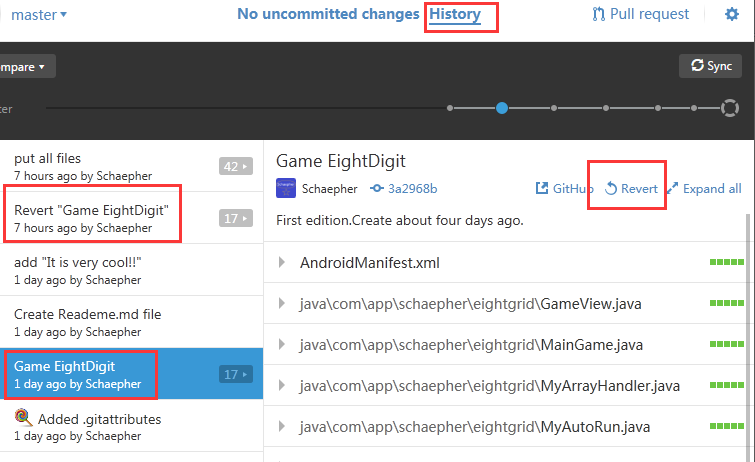

- GITHUB DESKTOP REVERT TO PREVIOUS COMMIT INSTALL
- GITHUB DESKTOP REVERT TO PREVIOUS COMMIT UPDATE
- GITHUB DESKTOP REVERT TO PREVIOUS COMMIT SOFTWARE
You can then `git push` this to the remote. Running `git revert` will do the opposite of what you just did (i.e., remove the plain text) and create a new commit. Say you added some plain text by mistake to `penguins.R`. Imagine you did some work, **committed** the changes, and **pushed** them to the remote repo. You can also find this on GitHub, by going to (). The content of the file should include the names of the files that you want Git to **not track**.Įach commit has a specific **hash** that identifies it. But it might get tedious to type out each file that you _do_ want to include by name.Ĭreate a file called `.gitignore` and place it in your repo. You might want to _not_ track certain files in your local repository, e.g., sensitive files such as credentials. To stage specific files in your repository, you can name them directly What this is doing under-the-hood is running a `git fetch` and then `git merge`.
GITHUB DESKTOP REVERT TO PREVIOUS COMMIT UPDATE
Your collaborators have been adding some awesome content to the repository, and you want to fetch their changes from the remote and update your local repository. Your branch is up to date with 'origin/master'. _After you stage the `penguins.R` file, but before you commit the changes._ No changes added to commit (use "git add" and/or "git commit -a") " to discard changes in working directory) _This happens when you have modified the script, but haven't staged your changes yet._ (Better) "Estimate logistic regression" 🎉 The repo () contains the `penguins.R` script, which works with data from the `palmerpenguins` library.Īes(x = bill_length_mm, y = bill_depth_mm, color = species)) + **Pull** any changes from the remote repository that your collaborators might have made Then, you will **push** your changes to the remote repositoryġ. Next, you will **commit** your changes and include an informative message, e.g. Work on the files/scripts, e.g., `penguins.R`ģ. **Clone** the repository that you want to work on from GitHub onto your local machineĢ.
GITHUB DESKTOP REVERT TO PREVIOUS COMMIT INSTALL
GitHub Desktop allows you to use Git through the Windows command prompt.īut we are going to install **Git Bash** which is a more useful shell.ġ. Once you start doing more complex operations, you will need the CLI.īackground-image: url(assets/remote-local.png) You can interact with Git using the **Graphical User Interface (GUI)** provided by GitHub Desktop, or through the **Command Line Interface (CLI)**. You edit and work on your content in your **local** repository on your computer, and then you send your changes to the remote. **GitHub Desktop** provides a user-friendly interface to use Git.
GITHUB DESKTOP REVERT TO PREVIOUS COMMIT SOFTWARE
**Git** is the software that allows us to do version control. 🤓 🔥 You can be braver when you code: if your new feature breaks, you can revert back to a version that worked! 👩🔬 📐 It imposes a certain discipline to your programming. As a result, the () is very thorough, but can often be overwhelming 🤯 if you are just starting.

Git is extremely powerful and there are myriad sophisticated things you can do with it. Here, we will focus on the tools you _actually_ need to start working collaboratively and putting your work under version control.

Class: title-slide-custom, title-slide, middle


 0 kommentar(er)
0 kommentar(er)
